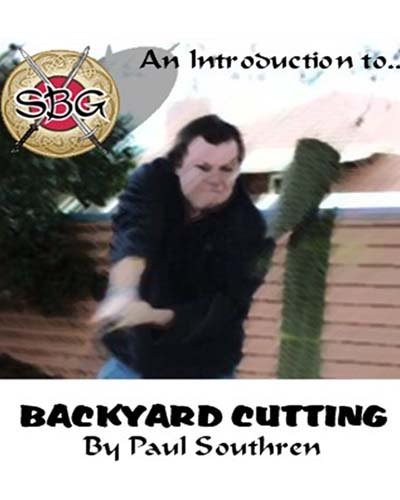Cutting Targets with Japanese Swords: Tips and Techniques
Cutting targets with Japanese swords isn't quite as simple as taking a baseball bat like swing and hoping for the best.
In addition to the correct selection of target, reasonably good technique and correct edge alignment is of paramount importance. But that said, anyone can become proficient cutting targets with Japanese swords in only a few swings if the basic foundation is good.
This article aims to give you that foundation.
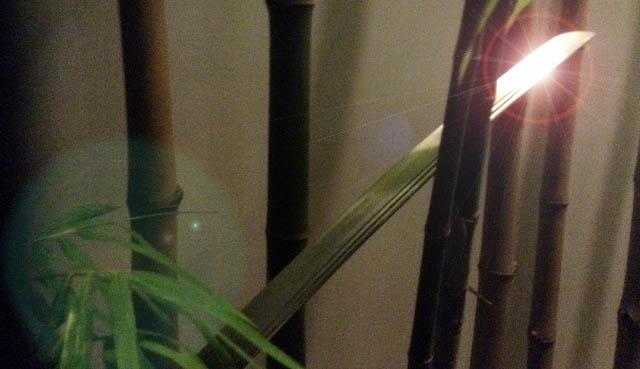
What are the best targets?
The Japanese Katana was traditionally a fairly fragile blade, especially when compared to European swords of the same period. However, unlike European swords, which were generally designed to withstand impact with a variety of targets, such as other swords, shields, armor and finally flesh and bone, the Katana was specialized to cut flesh and bone - and does it with such efficiency that over the years all sorts of legends have been attributed to it..
But the reality is, a real Katana - with a harder edge and softer shock absorbent spine, cannot handle abuse - and thus when considering an appropriate target, it is important to select a material that best approximates what Japanese swords were designed to cut..
In places where zombies are in short supply, the next best - and most commonly used - targets are rolled tatami mats and bamboo..
畳 - Tatami Mats
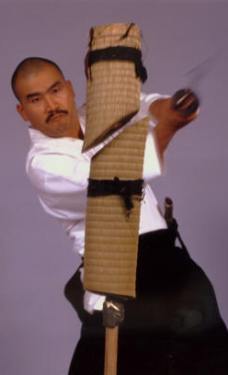
While quite expensive (typically around $10 a mat) tatami mats or goza (which are almost twice as challenging to cut as tatami, but visually almost identical) are the most traditional target - and cutting them with a set pattern of moves is known in JSA (Japanese Sword Arts) as 'Tameshigiri'.
The surface tension of a rolled and soaked tatami mat is quite similar to human skin, and the inner rolls, similar in consistency to muscle, connective tissue and even bone (which can further be simulated by inserting a green bamboo core - more on bamboo in a moment).
As such, a full tatami mat, properly rolled and soaked, approximates a human arm - and we know this because back in the day when the most common cutting targets with Japanese swords were condemned criminals, when they were phasing this practice out, cuts on tatami was directly compared to cuts on the unfortunate criminal, and found to be almost the same..
Now anyone who has cut tatami extensively may question this - as more often than not, a well made blade will sail right though as if the target is barely even there - and it is hard to fathom that a casual, fairly low powered slice could lop off an arm or a leg..
However, if you try cutting tatami with other blades - such as knives, machetes, etc - you will see that the target is indeed much more resistant than it may first appear.
The video below shows the results of testing a variety of edged weapons on a triple roll of tatami (which approximates a human thigh or neck), from folding knives, kitchen knives, bigger knives, and finally - a sword..
As you can see, the difference in cutting ability is quite dramatic and seems to prove the point - a folder or a kitchen knife will not take someone's arm off (well, not unless they are really co-operative and hold still for 10 mins or so). And the tests seems to reflect this - small knives cut the first and second layer, which is equivalent of cutting skin and a little into the muscle and tendons.
Bigger knives cut more layers, the Tanto felt like it would cut into the bone. But the sword - cuts it like butter and leaves little doubt as to its limb severing abilities..
Kind of scary stuff - but it clearly demonstrates why tatami make the best cutting targets with Japanese swords.
But the problem with tatami is that it is expensive, and very heavy - so costs a small fortune to ship.. And so, depending on where you live, another popular choice for cutting targets with Japanese swords is of course bamboo.
Bamboo
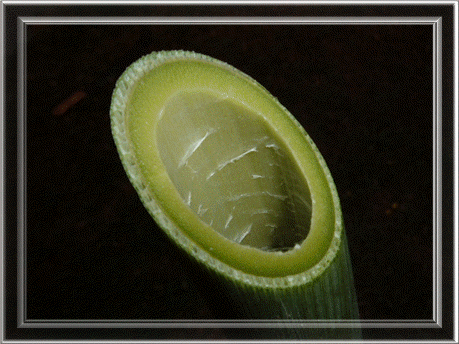
Often used in combination with a rolled tatami mat with a bamboo core, bamboo can and often is used by itself, and for many people, because it is renewable, essentially free it is one of the most popular cutting targets with Japanese swords.
Bamboo comes in many varieties, from thin river cane to giant bamboo so thick you cannot put both hands around it. The best and most challenging cutting targets with Japanese swords are made from the thicker stuff, but even river cane, when added to tatami as a core or bunched together, is still a good target to determine technique and edge alignment.
Like with tatami mats, when cutting targets with Japanese swords tended to be condemned criminals, it was found that bamboo has the same cut resistance as living human bone.. (living human bone is a lot different than dead bone. And while it may approximate the resistance of a living bone versus a blade, bone is much more resistant to blunt force than bamboo. But living bone was never designed to resist sharp steel moving at high speed..)
Like any time when cutting targets with Japanese swords, edge alignment and the correct cutting action is critical. The first time I cut the really thick stuff was in Longquan, China.
As you can see, the first person to attempt the cut (Jack Zheng, owner of one of the largest forges in Longquan) cuts effortlessly with minimal power. But it took me some time to figure out the correct cutting technique.
Power has little to do with it - a point we will come back to a little later in this article.
Non traditional cutting targets for Japanese swords
Essentially, bamboo and tatami mats are the two main traditional cutting targets for Japanese swords. But below are some contemporary and popular substitutions.
Paper Cuts
No, not the painful kind you get on your fingers, but cutting suspended paper is actually a traditional target and is especially popular with the Korean sword arts.
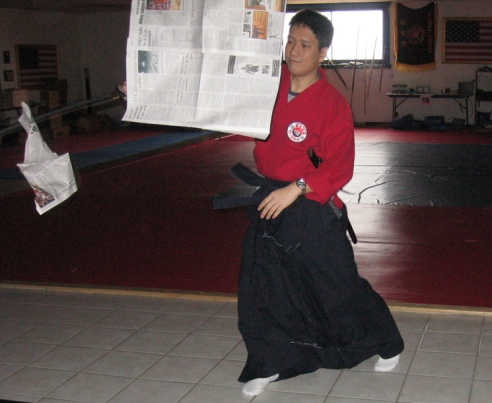
Speed, perfect edge alignment and an especially sharp sword are needed for this technique. And even then, it is a serious challenge - out of all of the cutting targets for Japanese swords, cutting suspended paper (newspaper or A4) is one of the most difficult.
Soaked and Rolled Newspaper Bundles
Often called 'the poor mans tatami' - a rolled newspaper, bound with string or rubber bands and soaked in water until it is heavy and saturated makes a reasonable - if more slightly challenging to cut - substitution for tatami mats.
When cutting newspaper rolls, good technique and speed is critical. Slow and heavy cuts almost always fail. The level of challenge can be increased by adding a wooden dowel core to the roll.
Water filled P.E.T. bottles
Water filled P.E.T. bottles (i.e. your typical plastic bottle for soda, water, etc) are exceptionally good cutting targets for Japanese swords due to their ready availability, almost zero cost and - quite simply - for the fun factor.
When filled with water, the skin of the bottle can be so tight as to deflect a bullet fired at it from a .22 calibre rifle. But with a decent cut on a P.E.T. bottle has such little resistance that it feels like nothing. Conversely, a BAD cut stops the sword dead in its tracks and sends shock-waves into the handle and your hands as it sends the target flying.
Note - technique is critical when cutting water bottles. If you do not 'pull' the blade through the target but rather 'hit' or 'strike' at it like it is a baseball bat and even the best blade is likely to approximate a home run as the uncut bottle flies across the yard and impacts heavily on the blade.
Hybrid Waterbottle/Bamboo

This clever idea was developed by a SBG member in the Philippines and involves affixing a length of river cane thickness bamboo INSIDE as a core to a P.E.T. water filled bottle and have been named 'Bamboo Water Bottles' (BWB).
No stands, no fuss and an extra level of challenge - click here to download the free ebook on how to make and use these innovative new cutting targets for Japanese swords.
Saplings
Good for those who live on rural properties that need the occasional clearing, softwood saplings make great cutting targets - but ONLY if the diameter is 3" or less and your edge alignment is absolutely spot on.
The problem with traditional Katana (i.e. those that have a real hamon from differentially tempering the blade) is that if the edge alignment is not perfect, they may well take a set.
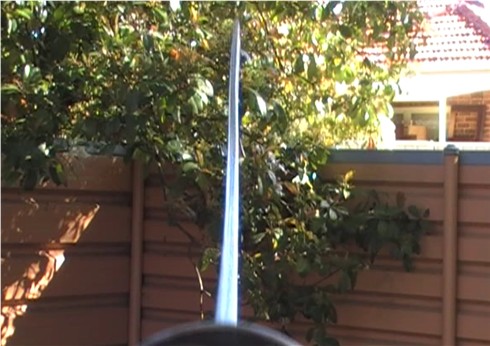 Bent blade after bad edge alignment cutting saplings with a $2000 master smith Katana..
Bent blade after bad edge alignment cutting saplings with a $2000 master smith Katana..What happens is the material inside a tree, which is completely different to human flesh and bone, tends to compact against the blade the deeper it cuts and any lateral movement will cause the blade to deform or possibly even break. Katana are not designed for heavy targets - at least, not the traditional ones..
The type of Katana determines the best targets..
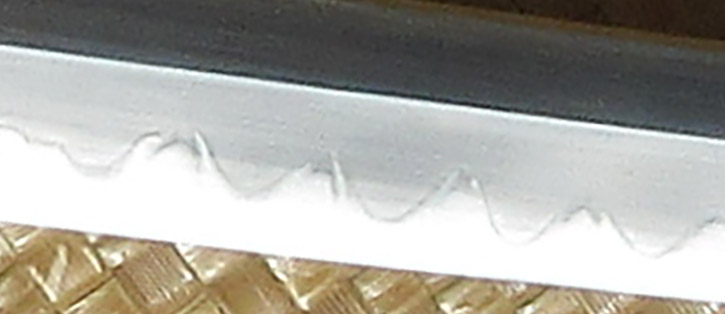 Hamon - the temper line which gives a traditional Katana its unique cutting properties
Hamon - the temper line which gives a traditional Katana its unique cutting propertiesWe touched on it briefly above and many times elsewhere on the site, but the market for functional Japanese swords is divided into two main types - traditional blades with a natural hamon and modern 'beater' blades that are monotempered like a European sword..
The differences are as below:
- A traditional blade has a much HARDER edge (HRC 60) and a softer spine (HRC40). If the whole blade was as hard as the edge, it would be too brittle for practical use. But the disadvantage is that the two toned steel does not 'bounce back' from strikes that cause the blade to deform.
- The harder edge not only allows it to be sharpened much more than the softer edge of a monotempered Katana, but the hardness itself increases the cutting ability of the blade against soft targets so that a razor sharp edge is not required. The mass, blade geometry, harder edge and correct technique do all the work - sharpness only really matters when cutting super light targets like suspended paper..
- When cutting targets with Japanese swords that have been differentially hardened, the extra hardeness and sharpness of the edge really does cut targets that simulate human flesh and bone much easier than a tough, monotempered sword.
So at the end of the day, the differentially hardened traditional Katana is truly specialized to easily cut targets that closely resemble the consistency of human flesh and bone, while monotempered swords can be used on a much wider variety of targets and be heavily abused.
You can read more on traditional Katana here and on monotempered 'beater' Katana here.
Sharpness has little to do with it, as you can plainly see in this review of what appeared to a very blunt Katana - yet the differentially hardened edge still allowed it to cut so well that it would lop off an arm without too much effort.. Never, ever judge the cutting ability of a sword on a casual observation of the apparent sharpness of its edge. The proof of the pudding is in the cutting results..
Cutting Technique
So far we have covered the main cutting targets for Japanese swords, traditional and contemporary, and taken a quick look at the two main types of blades you can cut said targets with. But none of this matters if your technique is a baseball bat like swing.
Sure, some swords will still cut even in the hands of the most unskilled cutter. But to be able to get the most out of cutting targets with Japanese swords, you need to have at least the basics down - and fortunately, contrary to what some elitists will tell you, decent cutting technique can be learned in as little as one or two cutting sessions..
The basic cutting action of a Katana is kind of like drawing the surface area of the blade through the target, slicing rather than striking in a fluid motion similar to casting out a fishing line. Below are the basic steps of a good cut.
Basic Technique for Cutting Targets with Japanese Swords
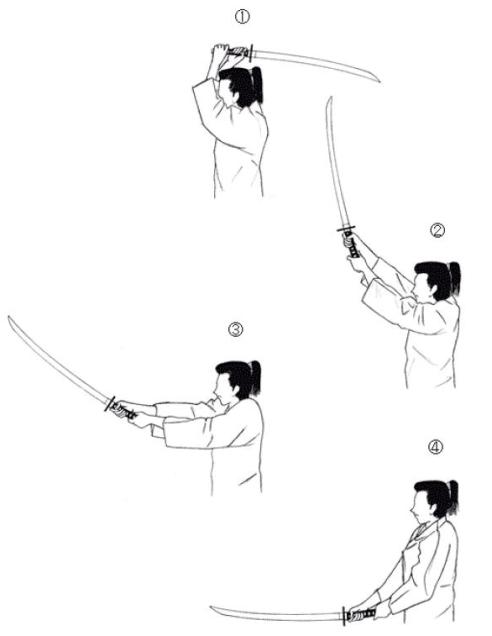
(1) Start with the blade raised above the head, elbows close to the body and blade almost horizontal.
(2) Begin 'casting' the blade forward and extend the arms, locking the elbows.
(3) Continue the casting motion, making contact with the target.
(4) Finish with good control, using the elbows are 'brakes'.
You can read more on basic techniques here - but in a nutshell, you need to ensure that you SLICE the target, not strike it. And that the edge is correctly aligned at all times. This last point will make up for a multitude of sins - my own technique is terrible, but my edge alignment is pretty decent, and makes up for my lack of formal training.
FINAL THOUGHTS AND FURTHER RESOURCES
There is a ton of additional reading on sword training and cutting here on our site. For a start, we recommend you download the free ebook, An introduction to backyard cutting - which details additional targets and what swords the are suitable for.
You can also find other ebooks and articles on sword training, cutting, techniques and much more in the Sword Fighting and Training Basics for Beginners section of the site.
Have fun, and enjoy safely cutting targets with Japanese swords - all it usually takes is one successful cut and it becomes pretty darned addictive. Try it for yourself and see..
I hope this article on cutting targets with Japanese swords has been helpful. To return to Sword Fighting and Training Basics for Beginners from Cutting Targets with Japanese Swords: Tips and Techniques, click here

Buying Swords Online Can Be DANGEROUS!
Find the Best Swords in the:
Popular & Recommended ARTICLES

The ONLY true free online magazine for sword enthusiasts. Delivered once a month on the 1st day of the month, no filler and no BS, just the latest sword news & info delivered straight to your inbox.

